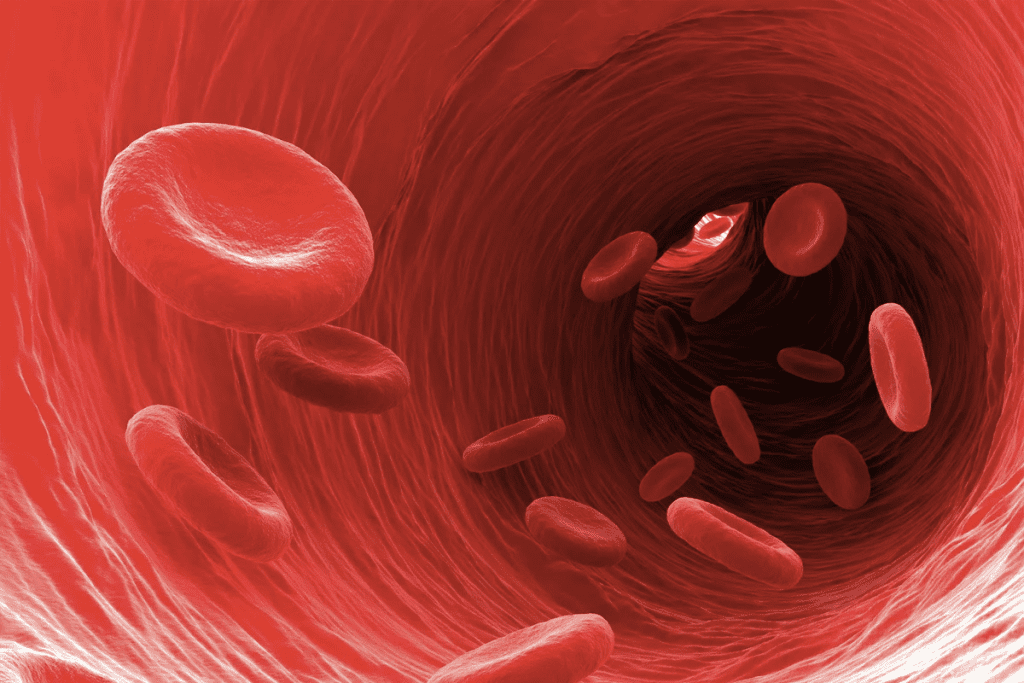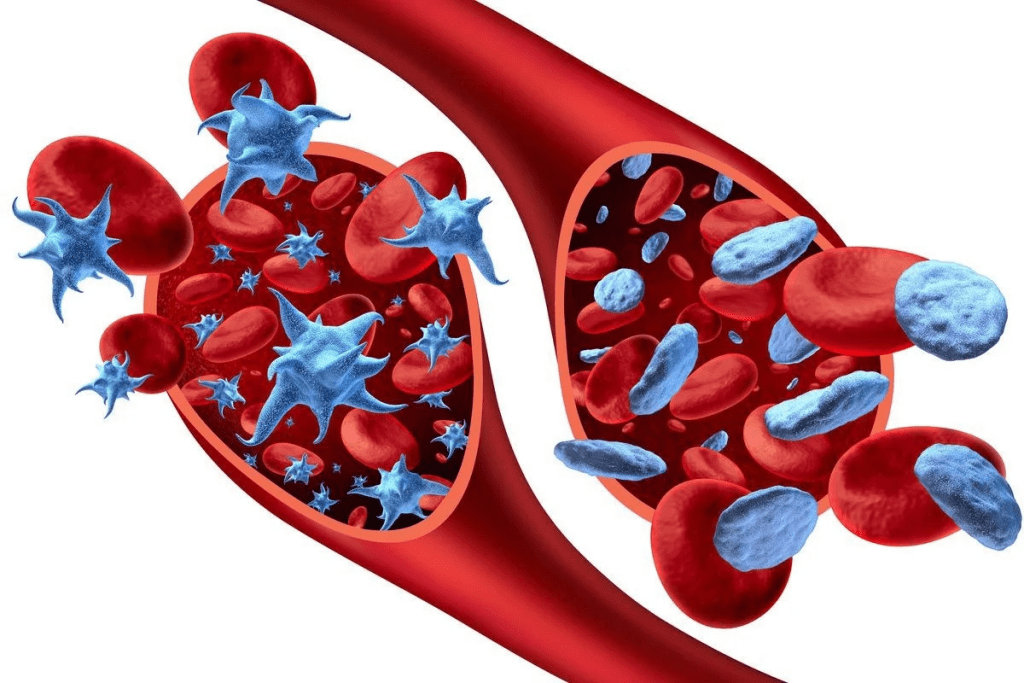Last Updated on November 13, 2025 by
How do you feel when platelets are low? Learn the negative symptoms of low platelets and why a high platelet count may also be a powerful concern.
When platelets are low, people might feel a lot of symptoms. These symptoms can really affect their day-to-day life. A low platelet count, or thrombocytopenia, can make you bruise easily, get petechiae, and bleed from small cuts.

Having a low platelet count is a worrying condition. It’s important to know the signs so you can get help fast. The Mayo Clinic says that thrombocytopenia can cause bleeding that lasts a long time. This can mean your body is having trouble healing.
Platelets are tiny blood cells that play a big role in our health. They help prevent too much bleeding. They are key in forming clots to stop bleeding when a blood vessel gets hurt.
Platelets, also known as thrombocytes, are small, colorless cell fragments in the blood. They are vital for blood clotting. According to the Cleveland Clinic, they form blood clots to stop bleeding. They are made in the bone marrow and move through the blood.

The main job of platelets is to stop bleeding by forming clots. When a blood vessel gets damaged, platelets stick to the injury. They clump together to form a plug that seals the damaged vessel. This is key for stopping bleeding and starting the healing process.
The role of platelets in blood clotting involves several key steps:
A normal platelet count is between 150,000 to 300,000 platelets per microliter of blood. Having a count in this range is important for proper blood clotting. It helps prevent too much bleeding or bruising.
Abnormalities in platelet count, like platelet count low (thrombocytopenia) or platelet count high (thrombocytosis), can cause serious health problems. Knowing about these conditions is key for proper diagnosis and treatment.
Thrombocytopenia is a condition where the blood can’t clot well because of low platelets. This can make bleeding more likely, either on its own or after an injury.

The Mayo Clinic says thrombocytopenia is when you have fewer than 135,000 platelets per microliter of blood if you’re a man. Women have a lower threshold of 157,000 platelets per microliter. It can happen for many reasons, like immune system problems, side effects from medicine, or issues with the bone marrow.
Thrombocytopenia is divided into different levels based on how low the platelet count is. Knowing the level helps doctors understand the risk of bleeding and how to treat it.
The risk of bleeding gets higher as the platelet count goes down. Knowing these risk levels is key to managing the condition and avoiding serious problems.
Key risk thresholds include:
People with severe thrombocytopenia need to see a doctor right away to prevent and manage bleeding problems.
When platelet counts drop, the body shows warning signs. We’ll look at symptoms of thrombocytopenia, a condition with low platelets. These signs can affect daily life and may point to a serious issue.
Easy bruising is a common sign of low platelets. Bruises appear as purple or red marks on the skin from minor injuries. Petechiae are small spots on the skin from tiny hemorrhages. They often show up on the legs, arms, or face.
Bleeding from mucous membranes is another symptom. This can show up as nosebleeds, bleeding gums, or mouth bleeding. Such bleeding can happen on its own or from minor injuries.
People with low platelet counts may bleed longer from cuts. Even small cuts can take a while to stop bleeding. This shows a problem with blood clotting.
Heavy menstrual periods, or menorrhagia, are a big symptom in women with thrombocytopenia. Prolonged or heavy bleeding during menstruation can cause anemia and other issues. It’s important to manage it well.
When platelet counts drop too low, severe symptoms and complications can happen. Thrombocytopenia can lead to life-threatening conditions that need quick medical help.
Internal bleeding is a severe symptom of low platelet count. It can show up as pain or swelling in the abdomen, back pain, or headache. If not treated fast, it can be deadly. We should watch for signs and get medical help right away if we notice anything odd.
Intracranial hemorrhage, or brain bleeding, is a serious risk with thrombocytopenia. The risk goes up with very low platelet counts. The Cleveland Clinic says severe thrombocytopenia raises the risk of internal bleeding or heart attack.
Symptoms of brain bleeding include severe headache, confusion, and trouble speaking or walking. Quick medical help is key in these cases.
Blood in the urine or stool is another sign of severe thrombocytopenia. It means there’s bleeding in the urinary or gastrointestinal tract. Hematuria, or blood in the urine, and melena, or black tarry stools, need quick medical check-ups.
These signs can lead to serious problems if not treated fast.
Severe thrombocytopenia can cause serious problems. These include internal bleeding, intracranial hemorrhage, and severe anemia from chronic bleeding. It’s vital to manage thrombocytopenia well to avoid these dangers.
Regular checks and sticking to treatment plans help lower the risks of low platelet counts.
Low platelet count, or thrombocytopenia, can cause many secondary symptoms. These symptoms affect both physical health and quality of life. They are as serious as the main symptoms and need full attention.
People with low platelet count often feel fatigue and weakness. This is even worse when they also have anemia, as the Mayo Clinic points out. Feeling tired all the time can make it hard to do daily tasks and hurt overall happiness.
The mental side of living with thrombocytopenia is very important. Anxiety and stress from the condition can really harm mental health. The fear of bleeding or bruising can make people stay away from social events and lower their quality of life.
Those with low platelet counts often can’t do things they used to because of the risk of injury or bleeding. Even simple tasks can be hard, leading to frustration and feeling like you need help all the time.
Finding good coping strategies is key to dealing with thrombocytopenia’s secondary symptoms. This might mean changing your lifestyle, like avoiding sports, being careful with daily tasks, and getting help from doctors and support groups.
It’s important to know why platelet counts drop. Low platelet count, or thrombocytopenia, can come from many sources. These include problems with making, moving, or destroying platelets.
Immune system problems can cause thrombocytopenia. This happens when the immune system attacks and destroys platelets. Immune thrombocytopenia (ITP) is a condition where the immune system makes antibodies against platelets. This can greatly lower platelet counts and increase the risk of bleeding.
Some medicines can cause low platelet counts as a side effect. Drugs like heparin and certain antibiotics can trigger an immune response against platelets. These drugs can affect how platelets are made or how long they last, leading to low counts.
The bone marrow makes platelets. Problems like leukemia, lymphoma, or bone marrow failure can stop platelet production. These issues can either harm the cells that make platelets or cause scarring in the bone marrow, making it hard to produce platelets.
Some infections and viruses can also lower platelet counts. Viruses like HIV, hepatitis C, and Epstein-Barr virus can harm platelet production or cause the immune system to destroy platelets. Sepsis, a severe infection response, can also lower platelet counts by affecting the body’s clotting system and platelet production.
An abnormally high platelet count, known as thrombocytosis, can increase the risk of blood clots and other cardiovascular complications. While thrombocytopenia is characterized by a low platelet count, thrombocytosis presents a different set of health concerns that need to be addressed.
Thrombocytosis is when the platelet count in the blood is too high. Normal platelet counts range from 150,000 to 450,000 platelets per microliter of blood. When it goes above this, it can lead to blood clots in the body’s vessels.
People with thrombocytosis might not show symptoms until a big problem happens. But, some may feel headaches, dizziness, or tingling in their hands and feet. In serious cases, it can cause deep vein thrombosis (DVT) or pulmonary embolism.
Thrombocytosis can be caused by two main types: primary and secondary. Primary thrombocytosis is linked to diseases that affect blood cell production in the bone marrow. Secondary thrombocytosis happens as a response to conditions like infections, inflammation, or iron deficiency.
Thrombocytosis can raise the risk of blood clots, leading to serious heart problems. The risk is higher for people with heart conditions. Treating thrombocytosis means fixing the underlying cause and lowering the risk of blood clots.
We will look at how to diagnose and treat thrombocytosis next. It’s key to provide full care for those with platelet disorders.
Understanding how to diagnose and treat low platelet count is key. Diagnosing thrombocytopenia requires a detailed approach. This includes various tests to find the cause of low platelets.
Healthcare providers use several tests to diagnose platelet disorders. These tests are:
Treatment for low platelet count aims to fix the root cause. The Mayo Clinic says treatments might include:
In severe cases, a platelet transfusion may be needed to prevent or treat bleeding.
Along with medical treatments, making lifestyle changes can help manage low platelet count. These include:
Keeping a healthy lifestyle, like eating well and seeing doctors regularly, is also important.
Knowing when to seek emergency care is vital. Look for these symptoms:
If you see these symptoms, get medical help right away. Quick action can greatly improve outcomes for severe thrombocytopenia.
Understanding and managing low platelet count, or thrombocytopenia, is key for those affected. We’ve looked at the causes, symptoms, diagnosis, and treatments. It’s clear that a team effort is needed to manage this condition well.
At livhospital.com, we’re dedicated to top-notch healthcare for international patients. By grasping the details of thrombocytopenia, people can get the right care. Quick medical help and a detailed care plan are essential for managing low platelet count.
People with thrombocytopenia can live active lives with the right support. Working closely with doctors and making smart care choices is vital. If symptoms don’t get better or get worse, it’s important to see a doctor.
A platelet count below 150,000 per microliter is considered low. This is known as thrombocytopenia.
Symptoms include easy bruising and petechiae. Heavy menstrual periods and prolonged bleeding from cuts are also common.
Causes include immune system disorders and medication side effects. Bone marrow conditions and infections can also lead to low platelet count.
Thrombocytosis is when the platelet count is too high. This can increase the risk of blood clots.
Diagnosis involves blood tests to check platelet count. Other tests help find the cause.
Treatment includes medical interventions and lifestyle changes. Precautions help manage the condition and prevent complications.
Seek emergency care for severe symptoms. This includes internal bleeding, intracranial hemorrhage, or life-threatening complications.
Yes, a high platelet count, or thrombocytosis, can increase the risk of blood clots and other complications.
It can cause fatigue and anxiety. It also limits daily activities, affecting quality of life.
Risks include internal bleeding and intracranial hemorrhage. Life-threatening complications can occur if not treated or managed well.
Yes, some medications can cause low platelet count as a side effect. This highlights the need for careful medical monitoring.
Subscribe to our e-newsletter to stay informed about the latest innovations in the world of health and exclusive offers!